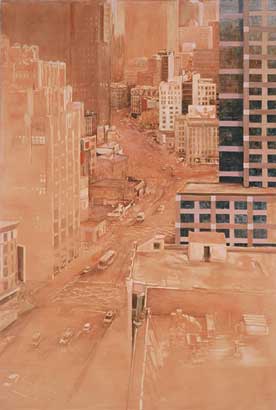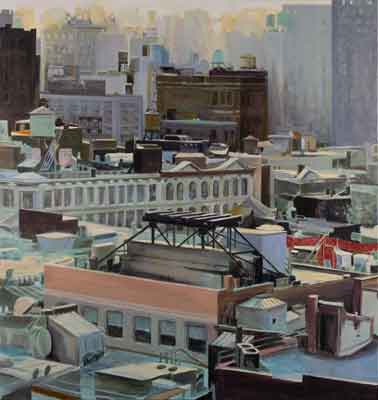
© Doug Martin
Spring Street, 2003.
Oil on canvas,
79" x 79"
Doug Martin: CityArt Review by Donald Goddard |
 © Doug Martin Spring Street, 2003. Oil on canvas, 79" x 79" |
Few paintings are as densely articulated as these. They are something like a cross between Camille Pissarro's rooftop views of Paris and Kurt Schwitters' collages of tickets and newspapers. Every building and street is identifiable, I guess, to Doug Martin (or to me), who has lived in and walked around SoHo for years, but it sort of doesn't matter. What does matter is the endless panoply of shapes and surfaces that don't even need to be invented, any more than Schwitters needed to invent the bus stubs he picked up on the street. What if birds lived here, or fish, or trees, as they did in the landscapes Martin painted earlier? Actually, they do, but the primary inhabitants are human beings, in the peculiar structures they devise for themselves, though no more peculiar, I suppose, than nests and lairs of various kinds, or beds of soil and crevices between rocks. People invariably live and work in boxes with windows, which signify smaller boxes within the large boxes. All the boxes are connected and continuous in a larger pattern that includes streets, but, of course, every one of them is somewhat disconcertingly different in materials, size, color, various details, and inhabitants. There are connections all over the place, but none at all, except spatial ones and generic ones of varying degrees. |
 © Doug Martin Downtown, 2002. Oil on canvas, 80" x 54" |
The results are vast fields that contain enormous amounts of information, way beyond our comprehension. Very few human figures are seen, or rather glimpsed, but evidence of them is everywhere because practically every detail is fashioned by them: various styles of architecture, traffic lights, water towers, pavement and bricks and stucco. It is the nature of these cityscapes to honor every bit of information and thereby to deny the possibility of any general pattern taking over, as was the case, for instance, in Mondrian's movement from patterns of building facades, trees, piers, and still lifes to grids of compositional abstraction. They are conglomerates that cannot be reduced precisely because the clamor they record is their meaning. They represent a screen through which the world is seen in a variety that could not have been predicted, any more than the narrowness of the building in the center right of Spring Street, or the particular yellow of its wall, could have been predicted. |
 © Doug Martin Sullivan Street, 2002. Oil on canvas, 45" x 80" |
The screen is light, through which every form is translated. Light is like the artist's vision, the artist's palette; it is there before there is a scene. And within it appear an extraordinary array of shapes and colors, which in turn partake of the light. In Downtown, buildings, cars, and street emerge glancingly from the overall orange glow as though this city were a phenomenon of nature in all its awakening variety, with a great river flowing down its center. But the organic surge of the painting is anchored by the very definitive grid of the modern building on the right, bringing the scene back to a constructed order. Sullivan Street too is suffused with an orange glow, which might be judged to be southwesterly, late afternoon light. With the sun in the southwest and the artist in the west, there is the implication that the sun sees everything, even that which the artist cannot see, the increasingly vague buildings in the distance, but what is only vaguely seen, or beyond that not seen at all, still continues the field of what can be seen. What is unknown is nonetheless known. Donald Goddard © 2004 |
Art Reviews Listings - Previous Review - Next Review
Art Review - NYArtWorld.com - NYAW.com. All artwork is copyright of the respective owner or artist. All other material © Copyright 2015 New York Art World ®. All Rights Reserved.
New York Art World ® - Back to Top